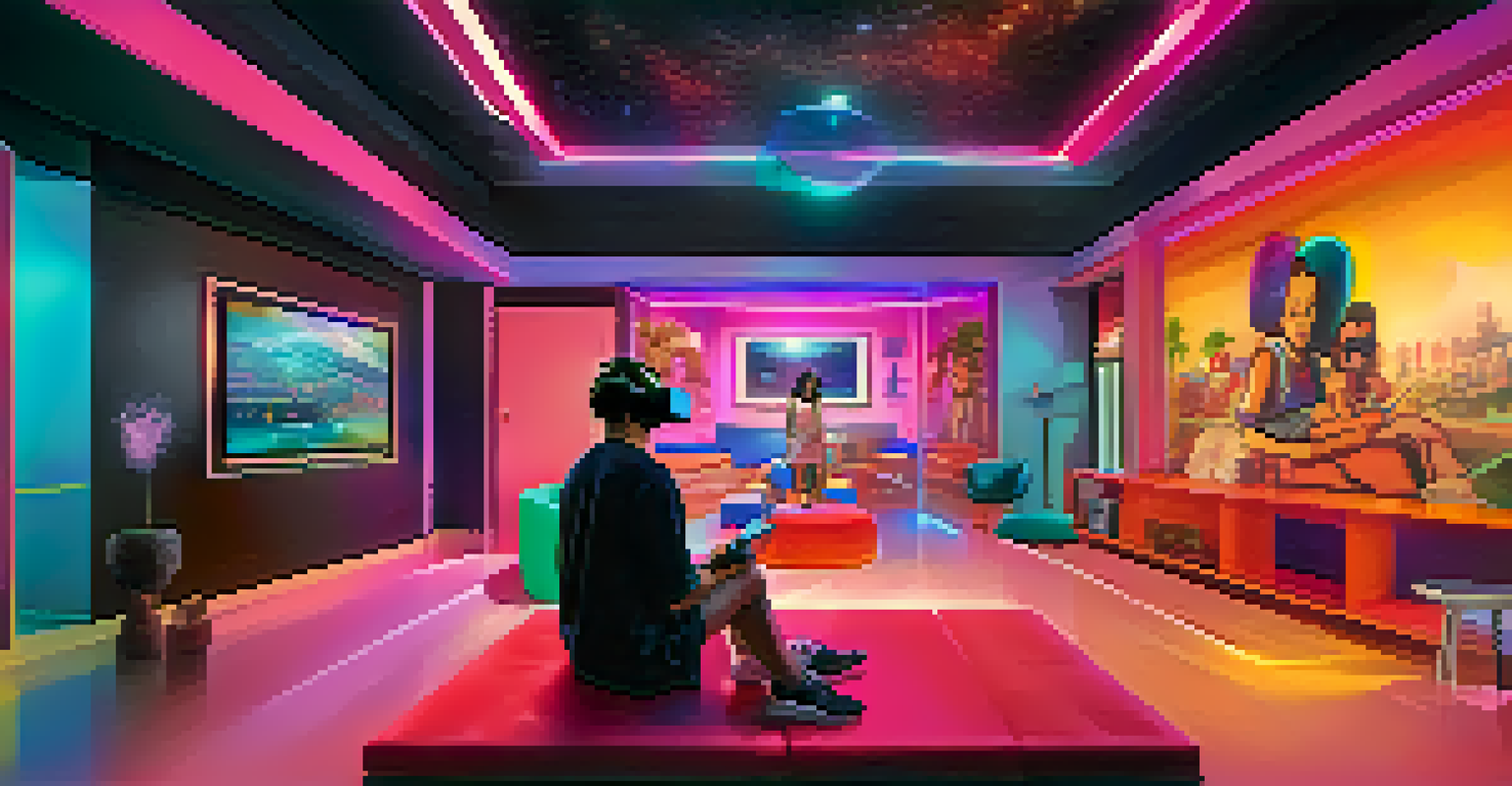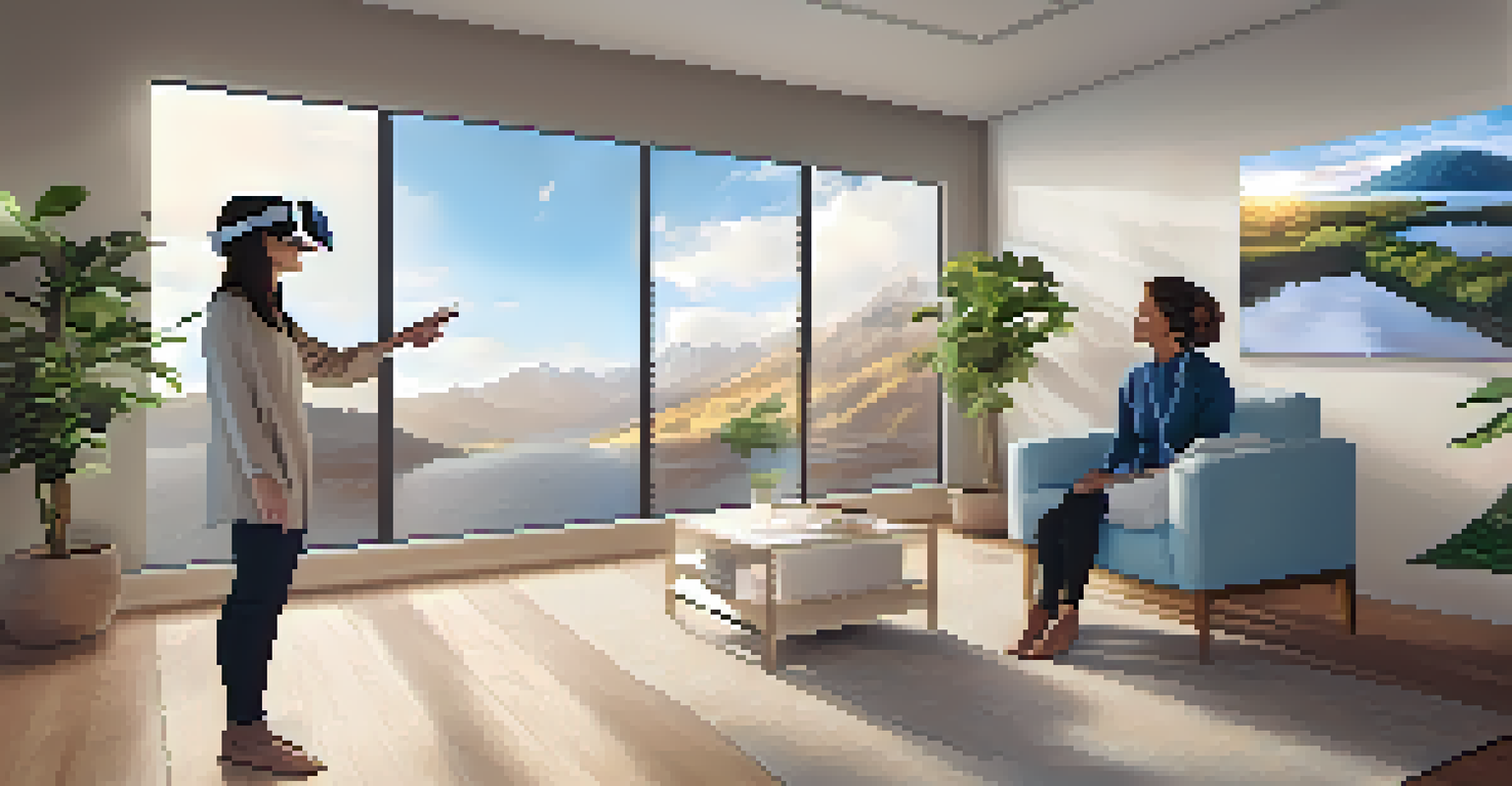Virtual Reality Therapy: A New Frontier in Addiction Treatment

Understanding Virtual Reality Therapy in Addiction Treatment
Virtual Reality Therapy (VRT) is an innovative method that immerses patients in a controlled virtual environment. This technology allows individuals to confront their triggers in a safe space, helping them develop coping strategies. By simulating real-life situations, VRT provides a unique opportunity to practice responses without the immediate risks associated with actual scenarios.
Virtual reality is an extraordinary tool that can help us change behavior and improve mental health outcomes.
Imagine a person struggling with substance abuse who can practice resisting urges in a virtual nightclub, complete with sounds and visuals. This immersive experience can make therapy feel more relevant and relatable. As they navigate these challenges, they build resilience and confidence to handle similar situations in real life.
VRT is not just about exposure; it's also about engaging the mind and emotions. By using interactive tools, patients can explore their thoughts and feelings surrounding addiction, leading to deeper insights and personal growth. This dynamic approach holds great promise for enhancing traditional treatment methods.
The Science Behind Virtual Reality Therapy
The effectiveness of Virtual Reality Therapy is backed by research that highlights its impact on behavior change. Studies have shown that VRT can significantly reduce cravings and increase motivation to stay sober. This technology leverages principles of cognitive-behavioral therapy, helping patients reframe negative thought patterns associated with addiction.

In a typical VRT session, patients are guided through scenarios that provoke their cravings. They learn to use coping mechanisms in real time, which can be a transformative experience. This hands-on approach allows individuals to see the consequences of their choices within the virtual world, reinforcing positive behaviors.
VRT Enhances Addiction Treatment
Virtual Reality Therapy provides immersive experiences that help individuals confront triggers and build coping strategies in a safe environment.
Additionally, VRT can help address co-occurring mental health issues often linked to addiction. By incorporating therapeutic techniques within the virtual environment, patients can confront anxiety, depression, or trauma that may contribute to their substance use. This holistic approach is key to fostering lasting recovery.
Benefits of Virtual Reality Therapy in Addiction Recovery
One of the standout benefits of VRT is its ability to create personalized treatment experiences. By tailoring scenarios to individual triggers, therapists can provide more targeted interventions. For someone with a history of social drinking, a virtual bar setting can be particularly effective in addressing their specific challenges.
The future of addiction treatment lies in integrating technology with traditional therapeutic methods.
Moreover, VRT offers a unique blend of engagement and motivation. Traditional therapy sessions can sometimes feel monotonous, but the interactive nature of virtual reality makes the process exciting and dynamic. Patients are often more willing to participate when they feel they are actively involved in their treatment.
Lastly, accessibility is a significant advantage of VRT. With the rise of telehealth, patients can access therapy from the comfort of their homes. This convenience can lower barriers to treatment, making it easier for individuals to seek help and stay committed to their recovery journey.
Challenges and Limitations of VRT
While Virtual Reality Therapy offers promising benefits, it's essential to recognize its limitations as well. Not everyone may feel comfortable in a virtual environment, and some individuals might experience motion sickness or anxiety when using VR technology. These issues can hinder the therapy's effectiveness and may require alternative approaches.
Additionally, the technology itself can be a barrier. Not all treatment centers have access to the equipment needed for VRT, which can limit its availability. Ensuring that therapists are adequately trained in using these tools is also crucial for maximizing their impact on patient outcomes.
Personalized Therapy with VRT
VRT allows therapists to tailor scenarios to individual triggers, creating more relevant and engaging treatment experiences.
Lastly, VRT should not be viewed as a standalone solution. Effective addiction treatment often requires a comprehensive approach, including counseling, support groups, and medical intervention when necessary. Integrating VRT with these traditional methods can enhance overall treatment effectiveness.
Real-World Applications of Virtual Reality Therapy
Several rehabilitation centers and research institutions have begun to implement VRT in their programs, showcasing its potential in real-world settings. For instance, some facilities use VR simulations to help patients practice social skills and refusal techniques in high-risk environments. These practical applications provide invaluable experiences that traditional therapy may not replicate.
In one notable case, a program utilized virtual reality to help veterans struggling with PTSD and substance use disorder. By immersing them in controlled environments that mimic triggers, therapists could guide them through exposure therapy while ensuring their safety. This innovative approach led to significant improvements in coping strategies and overall emotional well-being.
As more success stories emerge, the integration of VRT into addiction treatment is likely to grow. This evolution reflects a broader trend in healthcare towards personalized, technology-driven therapies that cater to the unique needs of patients. By embracing these advancements, we can hope for a future where addiction treatment is more effective and accessible.
The Role of Therapists in Virtual Reality Therapy
Therapists play a vital role in the success of Virtual Reality Therapy. Their expertise is essential for guiding patients through the virtual experiences and helping them process emotions that arise. A skilled therapist can facilitate discussions about what patients encounter in the VR environment, ensuring that insights gained translate to real-life situations.
Moreover, therapists must tailor the VR experiences to each patient's unique circumstances and struggles. This personalized approach helps to maximize the benefits of VRT, making it a relevant tool in their recovery. By understanding patients' triggers and emotional responses, therapists can create scenarios that challenge individuals in constructive ways.
Future of VRT Looks Promising
As technology advances, the integration of Virtual Reality Therapy with other treatment modalities will enhance addiction recovery strategies.
The therapeutic relationship remains a cornerstone of effective treatment, even in a virtual setting. Trust and rapport between the therapist and patient can enhance emotional safety, allowing individuals to explore sensitive topics without fear. This connection is crucial for fostering a supportive environment in which patients can thrive.
Looking Ahead: The Future of Virtual Reality Therapy
As technology continues to advance, the future of Virtual Reality Therapy in addiction treatment looks bright. With ongoing research, we can expect even more refined and effective applications of VR technology. Innovations such as augmented reality and artificial intelligence may further enhance the therapeutic experience, offering new dimensions to treatment.
Moreover, as awareness grows about the effectiveness of VRT, more treatment centers are likely to adopt these techniques. This shift could lead to a broader acceptance of technology-driven therapies within the mental health field, ultimately benefiting countless individuals seeking help for addiction.

Finally, the integration of VRT with other therapeutic modalities can create a more comprehensive approach to treatment. By combining traditional techniques with cutting-edge technology, we can pave the way for more effective strategies that empower individuals on their path to recovery.